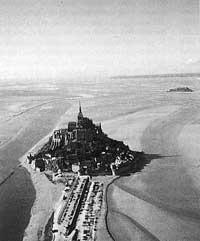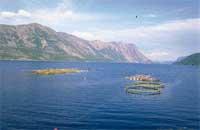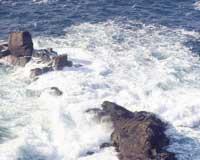High tide, low tide
1999/02/01 Susaeta, Tomasa Iturria: Elhuyar aldizkaria
The tides are daily movements of the great masses of water in the seas, caused by the force of attraction exerted by the Sun and the Moon on Earth that revolves around its axis.
The Earth supports the pull force of the Moon, but the distance between this star and each of the material particles that compose it is not the same, so not all particles bear the same pull force (the pull force is inversely proportional to the square of the distance between masses). Suppose the Moon is in the zenith of an area A of the Earth, the straight line passing through the Moon and point A also passes through the center of the Earth (point Z) and point B located in the antipodes of point A. Since the Moon is closer to A than C, the mass at point A will endure greater force of attraction than that in C and, on the contrary, the uptake in B will be lower than in C. If the Earth is considered to be a soft balloon covered with water and the water deforms easily, the greater attraction force existing in A will nullify part of the gravity force that pushes the water to the center of the planet and the sea will rise at point A and in zone A. And since the capture of the Moon in C is greater than in B, this force will cancel part of the gravity force in B and, although it may seem surprising, the water will rise at point B and in its vicinity, although slightly below what rises in A. And, of course, the water circulating to zones A and B will come from the regions between these two points, which will cause a decrease in sea level.

This is the static explanation of the tide (very simplified). But as the Earth is revolving around its axis, these water deposits will move across the surface of the Earth to be always looking towards the Moon and therefore revolve around the Earth's surface. Therefore, the tidal system is a dynamic system, with two waves, one main (point A) and one secondary (point B), that revolve around the Earth for a period of one day.
But the tide phenomenon is much more complex. To begin with, in the tides not only causes the Moon, but also does the Sun (much farther than the Moon). On the other hand, the Earth is not a solid core covered with water: The terrestrial surface is interspersed by seas, islands and continents, which causes significant changes in the simple model described above.
In addition to the interposition and force of attraction between the stars, complex resonance phenomena must be considered. The wave period on the water depends on the geometry of the vessel in which it is located. If two containers or two cubes of different size are taken, they are filled with water and a ball is thrown on the surface of the water in the center of each container, a wave is created: at the edge of each cube the water rises and drops periodically, but the oscillation period varies in each cube, since the period depends on the shape and size of the bucket. In the sea the same thing happens: the shape of the coast, the inbound and outbound, the relief of the seabed, the difference of depth... influence all the factors and, therefore, the sea does not behave like a single basin, but is a set of large, medium and small basins, each with its own oscillation period. In addition, the basins interact with each other and, if not enough, resonance phenomena occur, interferences, increasing the complexity of the phenomenon. This results in a wide variety of types of tides and systems.
Mareales curiosities
All these phenomena cause, for example, that in the center of the oceans and in the closed seas the tides have a very low amplitude (in the Mediterranean, for example, about 20 cm), or that in the North Atlantic or in some points of the Indian Ocean there is no low tide, while in the Canadian Bay of Fundy, in the Nova Scotia, the amplitude of 17 m, or that in our coast we have two. Or to put another example, that in Normandy, in Mont-Saint-Michel, the tide has an amplitude of almost 13 m, at the entrance of the channel of the Mancha near 6.5 m and on our coast, for example in Bilbao, at only 4 m.

Gai honi buruzko eduki gehiago
Elhuyarrek garatutako teknologia






